Scheduling Optimization of a Cabinet Refrigerator Incorporating a Phase Change Material to Reduce Its Indirect Environmental Impact
Abstract
:1. Introduction
2. Materials and Methods
2.1. Representative Energy Scenarios
- France presents the highest share of nuclear energy, but also it is characterized by a high wind energy share that helps to contribute to a notable lower carbon intensity;
- New Zealand electricity origin is similarly distributed in four sources: geothermal, gas, hydro, and “others”, including coal;
- The Polish fuel mix is mainly based on coal-burning based on its abundance in the mines. Renewable and nuclear power is mostly absent in the polish electricity generation system;
- In Denmark, almost half of the electricity is imported from neighboring countries (“others” cover 47% of the fuel mix). The following energy source by relevance is the wind power and then completed by coal, gas and photovoltaic (PV) with comparable influence;
- Germany is the national grid system with a presence of PV energy of all reported. Coal is also an important energy source, whereas the rest of the electricity sources are between 5% and 10%;
- The Brazilian fuel mix is characterized by the higher presence of the hydroelectric power being completed by wind energy and “others”;
- The Italian national grid highlights the significant amount of gas-powered electricity plants, which can be used in a higher efficiency combined cycle plant. A high wind power energy share can be depicted, which is followed by PV and coal;
- The Spanish situation is like that of Italy, with a more significant hydroelectric and nuclear power presence instead of wind and coal.
- Uruguayan electricity production is mainly based on wind energy, and then completed with hydropower energy and finally, biomass.
2.2. Optimization Problem and Analysis Methodology
3. Results and Discussion
3.1. Daily Carbon Emission Optimization
3.2. Statistical Analysis
3.3. Comparison with Cost-Optimized Operations
4. Conclusions
Author Contributions
Funding
Data Availability Statement
Conflicts of Interest
References
- United Nations Paris Climate Change Conference-November 2015, COP 21. In Proceedings of the Adoption of The Paris Agreement, Paris, France, 30 November–11 December 2015; 2015. Available online: https://unfccc.int/resource/docs/2015/cop21/eng/l09r01.pdf (accessed on 9 April 2021).
- IEA. Global Energy and CO2 Status Report 2018. The Latest Trends in Energy and Emissions in 2018; IEA: Paris, France, 2019. [Google Scholar]
- IPCC. Climate Change 2014: Mitigation of Climate Change. Contribution of Working Group III to the Fifth Assessment Report of the Intergovernmental Panel on Climate Change, AR5 ed.; Edenhofer, O., Pichs-Madruga, R., Sokona, Y., Farahani, E., Kadner, S., Seyboth, K., Adler, A., Baum, I., Brunner, S., Eickemeier, P., et al., Eds.; Cambridge University Press: Cambridge, UK; New York, NY, USA, 2014. [Google Scholar]
- Gielen, D.; Boshell, F.; Saygin, D.; Bazilian, M.D.; Wagner, N.; Gorini, R. The role of renewable energy in the global energy transformation. Energy Strateg. Rev. 2019, 24, 38–50. [Google Scholar] [CrossRef]
- Winkler, J.; Gaio, A.; Pfluger, B.; Ragwitz, M. Impact of renewables on electricity markets—Do support schemes matter? Energy Policy 2016, 93, 157–167. [Google Scholar] [CrossRef]
- Braeuer, F.; Rominger, J.; McKenna, R.; Fichtner, W. Battery storage systems: An economic model-based analysis of parallel revenue streams and general implications for industry. Appl. Energy 2019, 239, 1424–1440. [Google Scholar] [CrossRef]
- Winkler, J.; Pudlik, M.; Ragwitz, M.; Pfluger, B. The market value of renewable electricity—Which factors really matter? Appl. Energy 2016, 184, 464–481. [Google Scholar] [CrossRef]
- Pursiheimo, E.; Holttinen, H.; Koljonen, T. Inter-sectoral effects of high renewable energy share in global energy system. Renew. Energy 2019. [Google Scholar] [CrossRef]
- Mosquera-López, S.; Nursimulu, A. Drivers of electricity price dynamics: Comparative analysis of spot and futures markets. Energy Policy 2019, 126, 76–87. [Google Scholar] [CrossRef]
- Zipp, A. The marketability of variable renewable energy in liberalized electricity markets—An empirical analysis. Renew. Energy 2017, 113, 1111–1121. [Google Scholar] [CrossRef]
- Kyritsis, E.; Andersson, J.; Serletis, A. Electricity prices, large-scale renewable integration, and policy implications. Energy Policy 2017, 101, 550–560. [Google Scholar] [CrossRef] [Green Version]
- Paraschiv, F.; Erni, D.; Pietsch, R. The impact of renewable energies on EEX day-ahead electricity prices. Energy Policy 2014, 73, 196–210. [Google Scholar] [CrossRef] [Green Version]
- Eid, C.; Koliou, E.; Valles, M.; Reneses, J.; Hakvoort, R. Time-based pricing and electricity demand response: Existing barriers and next steps. Util. Policy 2016, 40, 15–25. [Google Scholar] [CrossRef] [Green Version]
- Hansen, K.; Breyer, C.; Lund, H. Status and perspectives on 100% renewable energy systems. Energy 2019, 175, 471–480. [Google Scholar] [CrossRef]
- Hu, M.; Xiao, F.; Jørgensen, J.B.; Wang, S. Frequency control of air conditioners in response to real-time dynamic electricity prices in smart grids. Appl. Energy 2019, 242, 92–106. [Google Scholar] [CrossRef]
- Schné, T.; Jaskó, S.; Simon, G. Embeddable adaptive model predictive refrigerator control for cost-efficient and sustainable operation. J. Clean. Prod. 2018, 190, 496–507. [Google Scholar] [CrossRef]
- Nakabi, T.A.; Toivanen, P. An ANN-based model for learning individual customer behavior in response to electricity prices. Sustain. Energy Grids Netw. 2019, 18, 100212. [Google Scholar] [CrossRef]
- Yalcintas, M.; Hagen, W.T.; Kaya, A. Time-based electricity pricing for large-volume customers: A comparison of two buildings under tariff alternatives. Util. Policy 2015, 37, 58–68. [Google Scholar] [CrossRef]
- Cohen, F.; Glachant, M.; Söderberg, M. The impact of energy prices on product innovation: Evidence from the UK refrigerator market. Energy Econ. 2017, 68, 81–88. [Google Scholar] [CrossRef] [Green Version]
- Niro, G.; Salles, D.; Alcântara, M.V.P.; da Silva, L.C.P. Large-scale control of domestic refrigerators for demand peak reduction in distribution systems. Electr. Power Syst. Res. 2013, 100, 34–42. [Google Scholar] [CrossRef]
- Zehir, M.A.; Bagriyanik, M. Demand Side Management by controlling refrigerators and its effects on consumers. Energy Convers. Manag. 2012, 64, 238–244. [Google Scholar] [CrossRef]
- Bálint, R.; Fodor, A.; Hangos, K.M.; Magyar, A. Cost-optimal model predictive scheduling of freezers. Control Eng. Pract. 2018, 80, 61–69. [Google Scholar] [CrossRef] [Green Version]
- Mohammad, N.; Rahman, A. Transactive control of industrial heating-ventilation-air-conditioning units in cold-storage warehouses for demand response. Sustain. Energy Grids Netw. 2019, 18, 100201. [Google Scholar] [CrossRef]
- Hu, M.; Xiao, F.; Jørgensen, J.B.; Li, R. Price-responsive model predictive control of floor heating systems for demand response using building thermal mass. Appl. Therm. Eng. 2019, 153, 316–329. [Google Scholar] [CrossRef]
- Biyik, E.; Kahraman, A. A predictive control strategy for optimal management of peak load, thermal comfort, energy storage and renewables in multi-zone buildings. J. Build. Eng. 2019, 25, 100826. [Google Scholar] [CrossRef]
- Tabares-Velasco, P.C.; Speake, A.; Harris, M.; Newman, A.; Vincent, T.; Lanahan, M. A modeling framework for optimization-based control of a residential building thermostat for time-of-use pricing. Appl. Energy 2019, 242, 1346–1357. [Google Scholar] [CrossRef]
- Ringkjøb, H.-K.; Haugan, P.M.; Solbrekke, I.M. A review of modelling tools for energy and electricity systems with large shares of variable renewables. Renew. Sustain. Energy Rev. 2018, 96, 440–459. [Google Scholar] [CrossRef]
- Azhgaliyeva, D. Energy Storage and Renewable Energy Deployment: Empirical Evidence from OECD countries. Energy Procedia 2019, 158, 3647–3651. [Google Scholar] [CrossRef]
- Gang, W.; Wang, S.; Xiao, F.; Gao, D. District cooling systems: Technology integration, system optimization, challenges and opportunities for applications. Renew. Sustain. Energy Rev. 2016, 53, 253–264. [Google Scholar] [CrossRef]
- Li, Y.; Rezgui, Y.; Zhu, H. District heating and cooling optimization and enhancement—Towards integration of renewables, storage and smart grid. Renew. Sustain. Energy Rev. 2017, 72, 281–294. [Google Scholar] [CrossRef]
- Child, M.; Kemfert, C.; Bogdanov, D.; Breyer, C. Flexible electricity generation, grid exchange and storage for the transition to a 100% renewable energy system in Europe. Renew. Energy 2019, 139, 80–101. [Google Scholar] [CrossRef]
- Dostál, Z.; Ladányi, L. Demands on energy storage for renewable power sources. J. Energy Storage 2018, 18, 250–255. [Google Scholar] [CrossRef]
- Paiho, S.; Saastamoinen, H.; Hakkarainen, E.; Similä, L.; Pasonen, R.; Ikäheimo, J.; Rämä, M.; Tuovinen, M.; Horsmanheimo, S. Increasing flexibility of Finnish energy systems—A review of potential technologies and means. Sustain. Cities Soc. 2018, 43, 509–523. [Google Scholar] [CrossRef]
- She, X.; Cong, L.; Nie, B.; Leng, G.; Peng, H.; Chen, Y.; Zhang, X.; Wen, T.; Yang, H.; Luo, Y. Energy-efficient and -economic technologies for air conditioning with vapor compression refrigeration: A comprehensive review. Appl. Energy 2018, 232, 157–186. [Google Scholar] [CrossRef]
- Nazir, H.; Batool, M.; Bolivar Osorio, F.J.; Isaza-Ruiz, M.; Xu, X.; Vignarooban, K.; Phelan, P.; Inamuddin; Kannan, A.M. Recent developments in phase change materials for energy storage applications: A review. Int. J. Heat Mass Transf. 2019, 129, 491–523. [Google Scholar] [CrossRef]
- Zhou, E.; Cole, W.; Frew, B. Valuing variable renewable energy for peak demand requirements. Energy 2018, 165, 499–511. [Google Scholar] [CrossRef]
- Mastani Joybari, M.; Haghighat, F.; Moffat, J.; Sra, P. Heat and cold storage using phase change materials in domestic refrigeration systems: The state-of-the-art review. Energy Build. 2015, 106, 111–124. [Google Scholar] [CrossRef]
- Killian, M.; Kozek, M. Ten questions concerning model predictive control for energy efficient buildings. Build. Environ. 2016, 105, 403–412. [Google Scholar] [CrossRef]
- Pertzborn, A. Using distributed agents to optimize thermal energy storage. J. Energy Storage 2019, 23, 89–97. [Google Scholar] [CrossRef]
- Kamal, R.; Moloney, F.; Wickramaratne, C.; Narasimhan, A.; Goswami, D.Y. Strategic control and cost optimization of thermal energy storage in buildings using EnergyPlus. Appl. Energy 2019, 246, 77–90. [Google Scholar] [CrossRef]
- Bista, S.; Hosseini, S.E.; Owens, E.; Phillips, G. Performance improvement and energy consumption reduction in refrigeration systems using phase change material (PCM). Appl. Therm. Eng. 2018, 142, 723–735. [Google Scholar] [CrossRef]
- Yusufoglu, Y.; Apaydin, T.; Yilmaz, S.; Paksoy, H.O. Improving performance of household refrigerators by incorporating phase change materials. Int. J. Refrig. 2015, 57, 173–185. [Google Scholar] [CrossRef]
- Maiorino, A.; Del Duca, M.G.; Mota-Babiloni, A.; Greco, A.; Aprea, C. The thermal performances of a refrigerator incorporating a phase change material. Int. J. Refrig. 2019, 100, 255–264. [Google Scholar] [CrossRef]
- Maiorino, A.; Del Duca, M.G.; Mota-Babiloni, A.; Aprea, C. Achieving a running cost saving with a cabinet refrigerator incorporating a phase change material by the scheduling optimisation of its cyclic operations. Int. J. Refrig. 2020, 117, 237–246. [Google Scholar] [CrossRef]
- Tomorrow, ElectricityMap. (n.d.). Available online: https://www.electricitymap.org/zone (accessed on 6 June 2019).

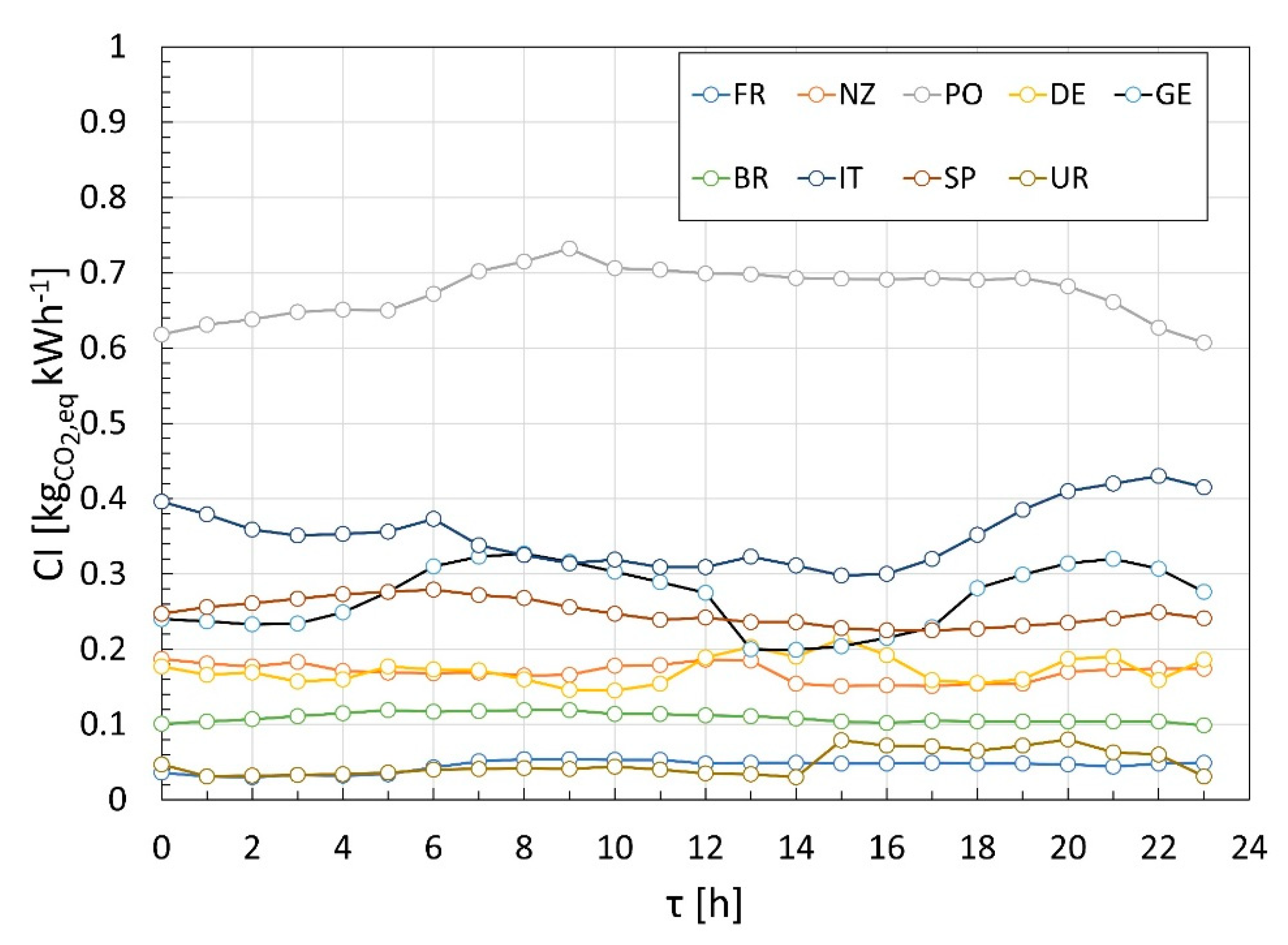

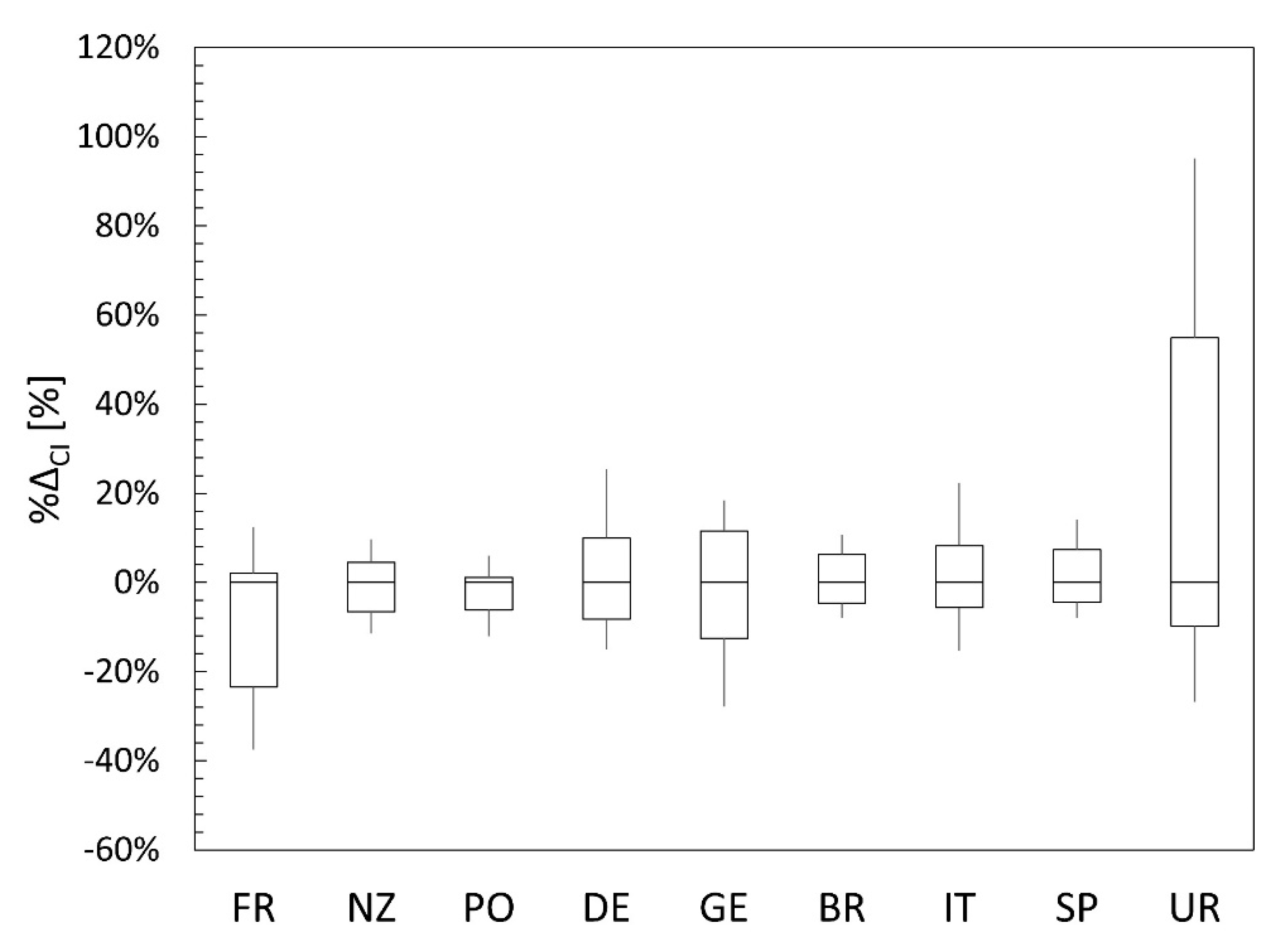
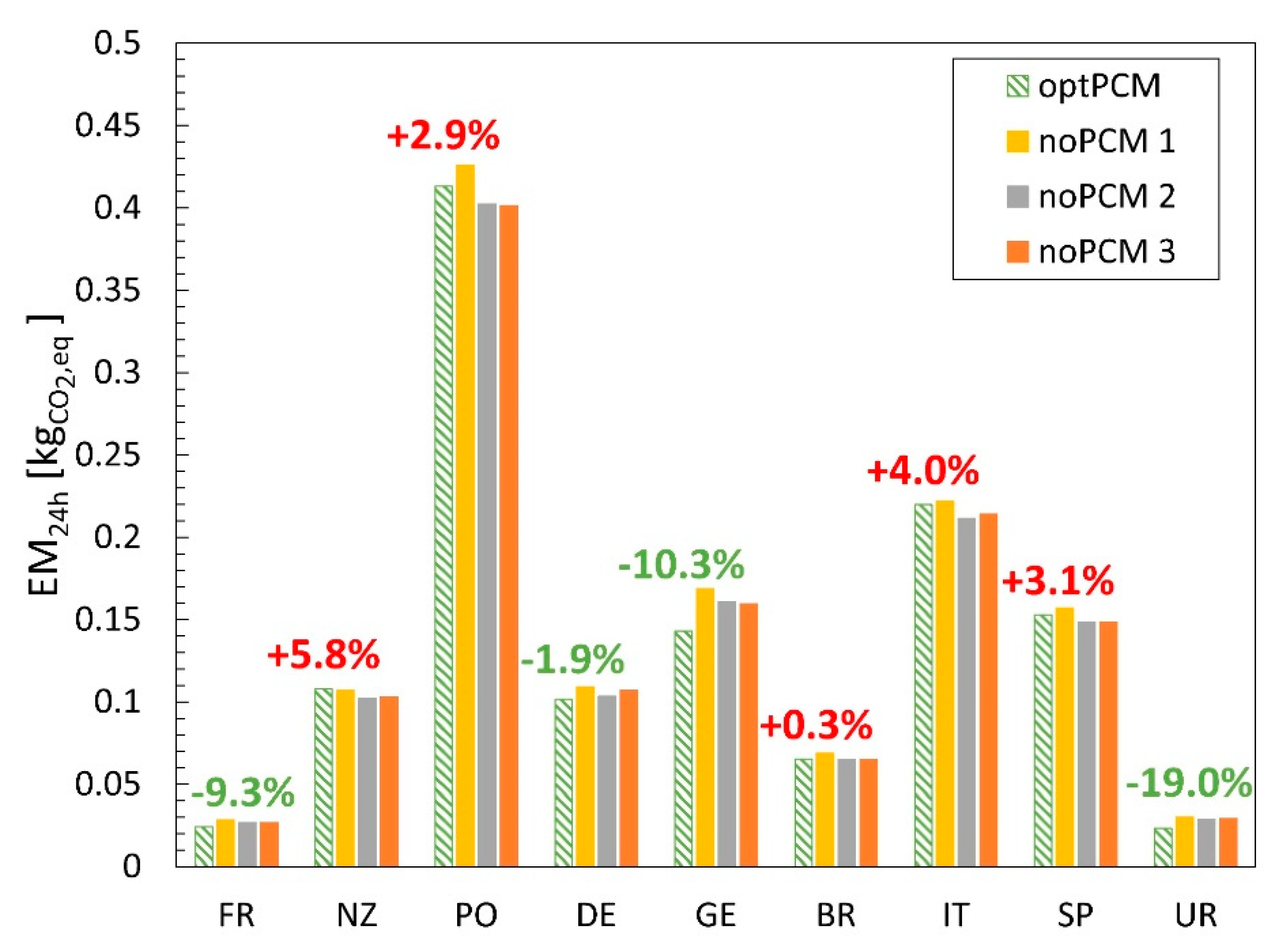
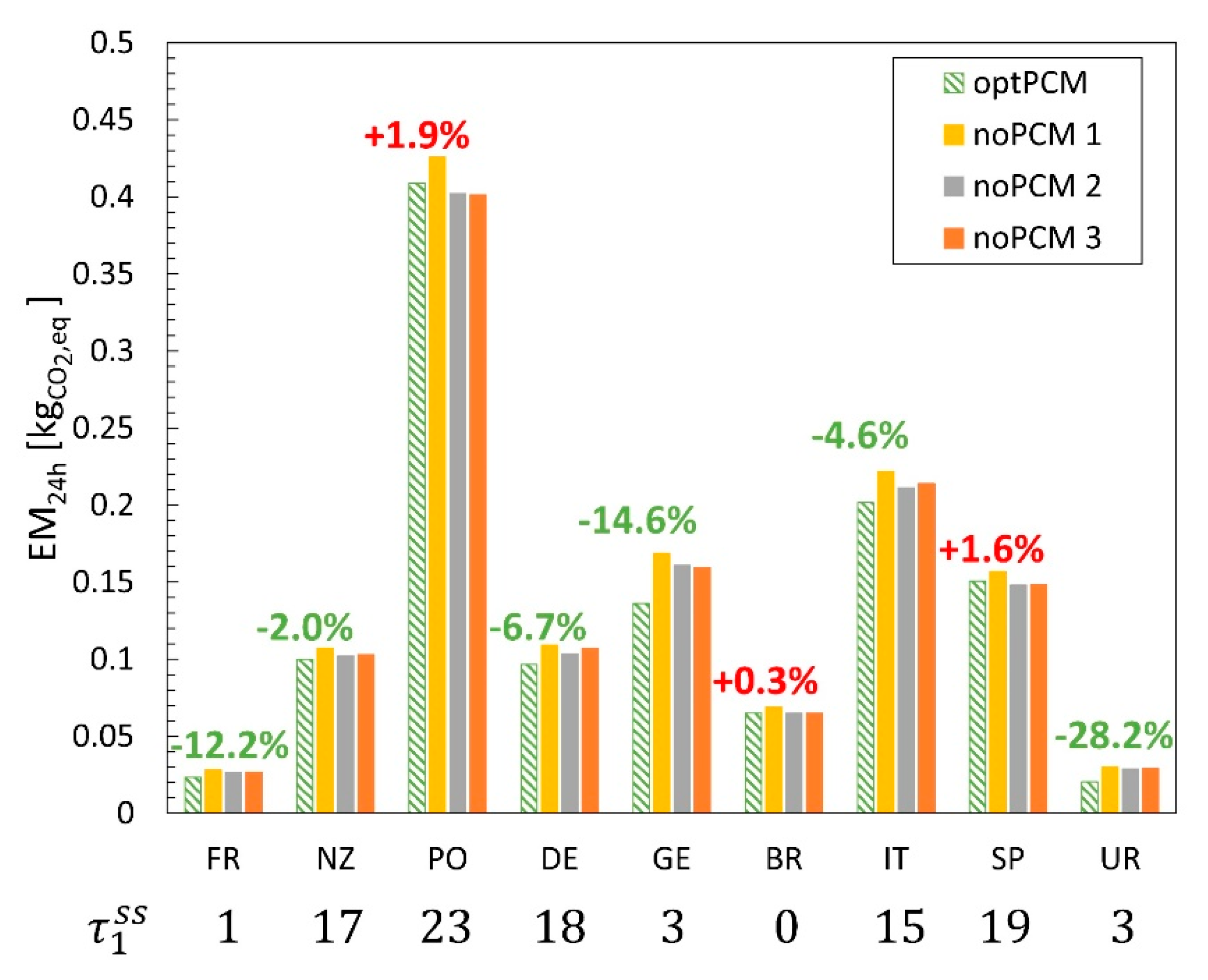
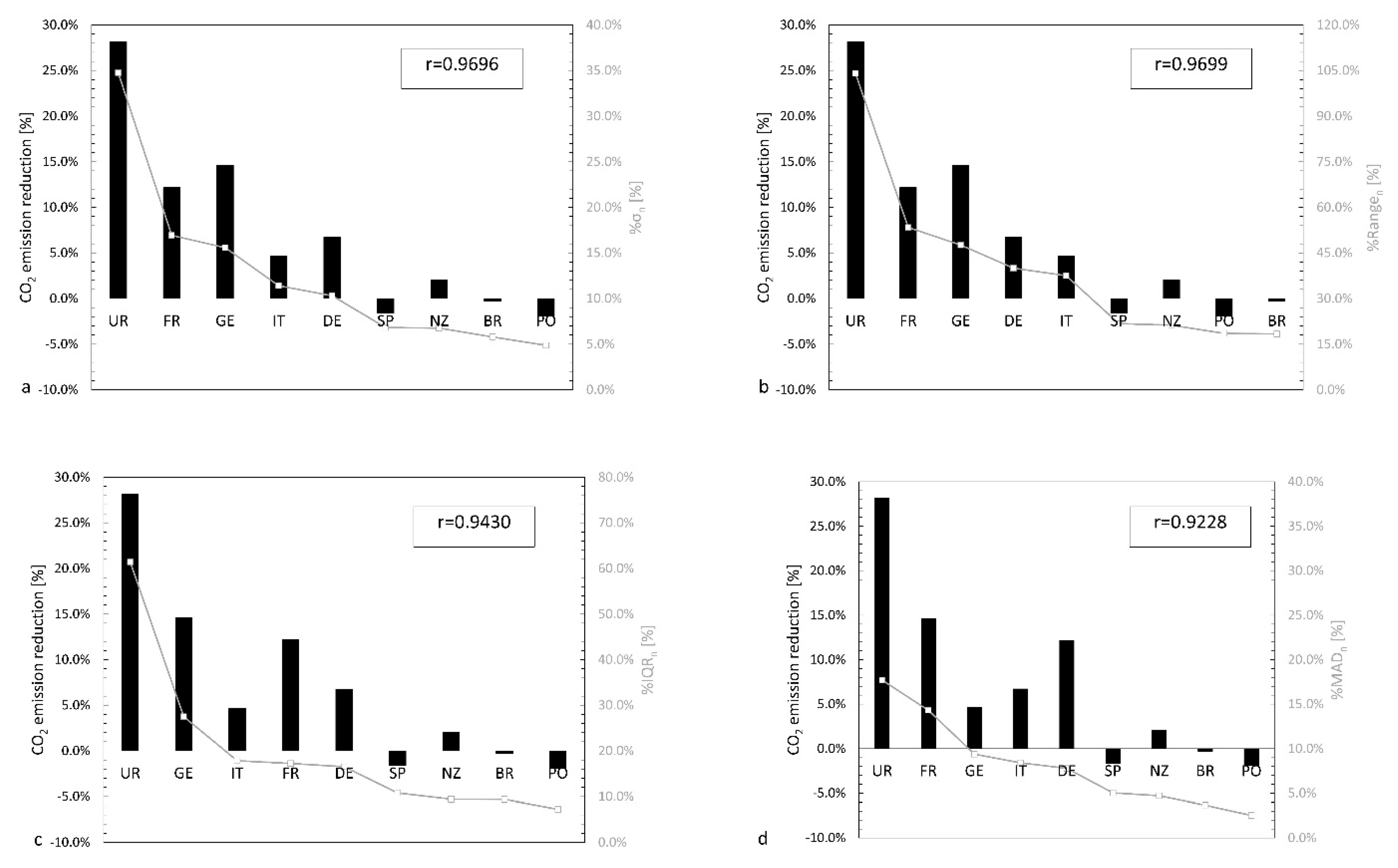

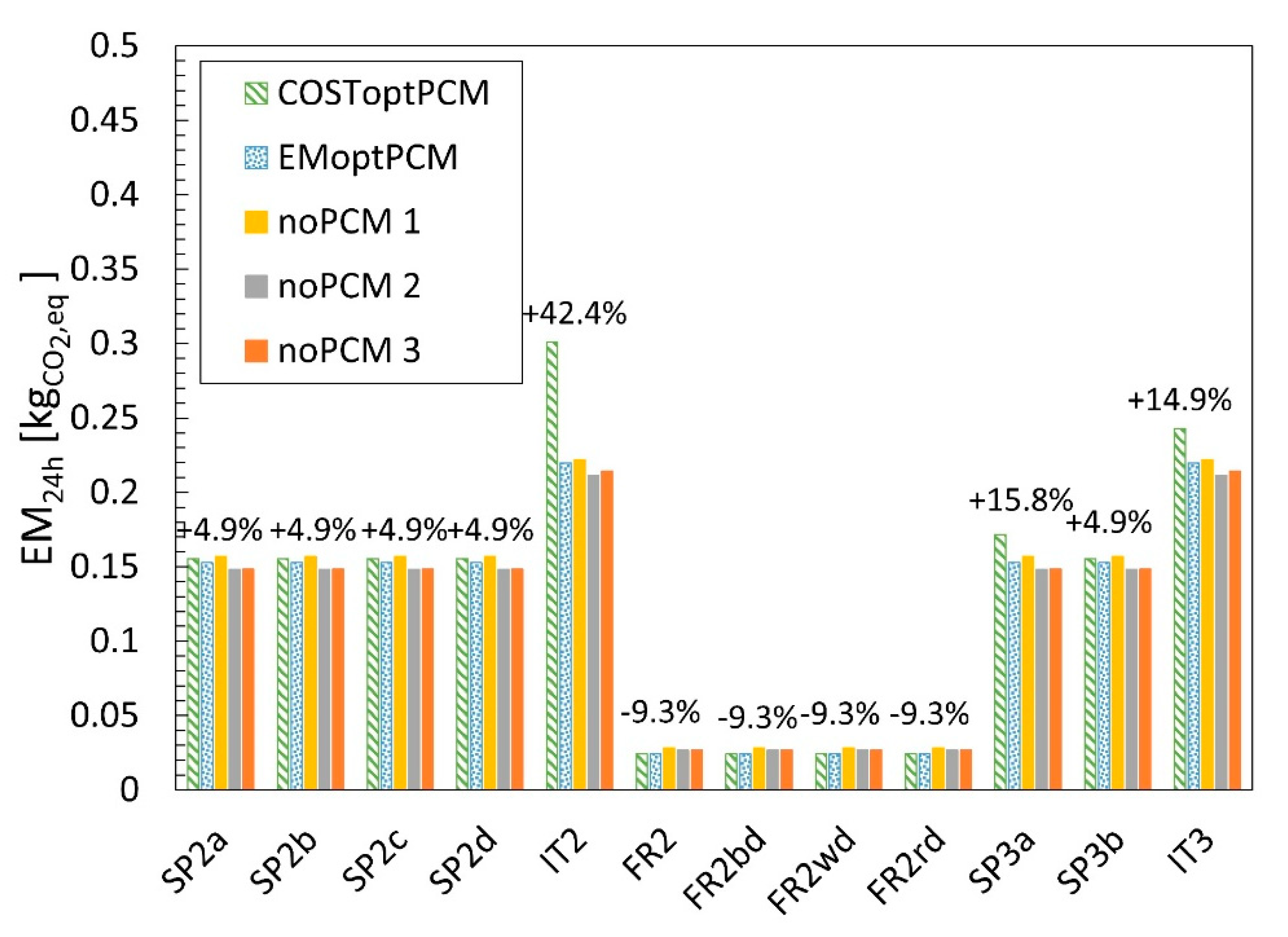
| Δexp (K) | τON (s) | τOFF (s) | P (W) | |
|---|---|---|---|---|
| with PCM | 1 | 1263 | 9112 | 215.2 |
| 2 | 4322 | 32,337 | 218.0 | |
| 3 | 6040 | 48,420 | 221.9 | |
| without PCM | 1 | 233 | 1653 | 212.2 |
| 2 | 638 | 4923 | 210.6 | |
| 3 | 1027 | 8325 | 210.5 |
Publisher’s Note: MDPI stays neutral with regard to jurisdictional claims in published maps and institutional affiliations. |
© 2021 by the authors. Licensee MDPI, Basel, Switzerland. This article is an open access article distributed under the terms and conditions of the Creative Commons Attribution (CC BY) license (https://creativecommons.org/licenses/by/4.0/).
Share and Cite
Maiorino, A.; Mota-Babiloni, A.; Del Duca, M.G.; Aprea, C. Scheduling Optimization of a Cabinet Refrigerator Incorporating a Phase Change Material to Reduce Its Indirect Environmental Impact. Energies 2021, 14, 2154. https://doi.org/10.3390/en14082154
Maiorino A, Mota-Babiloni A, Del Duca MG, Aprea C. Scheduling Optimization of a Cabinet Refrigerator Incorporating a Phase Change Material to Reduce Its Indirect Environmental Impact. Energies. 2021; 14(8):2154. https://doi.org/10.3390/en14082154
Chicago/Turabian StyleMaiorino, Angelo, Adrián Mota-Babiloni, Manuel Gesù Del Duca, and Ciro Aprea. 2021. "Scheduling Optimization of a Cabinet Refrigerator Incorporating a Phase Change Material to Reduce Its Indirect Environmental Impact" Energies 14, no. 8: 2154. https://doi.org/10.3390/en14082154









